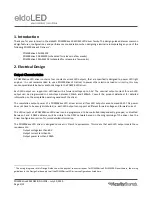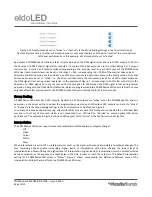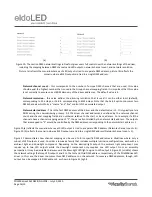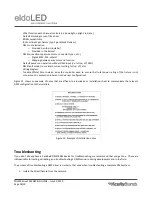
POWERdrive 50W DESIGN GUIDE
–
July 30, 2020
Page 7/19
Meeting Title 24/JA8 startup
The POWERdrive LED driver can meet the startup time requirements as specified in California Title 24/JA8 out of the box,
i.e. there is n
o need to order a “special”
configuration. However, this does require the test setup to meet certain
conditions.
Per the DMX512A standard, a POWERdrive LED driver will wait 1250ms after cold start for a valid DMX control signal to be
presented on the input. If no DMX input is received within 1250ms after cold start, the POWERdrive LED driver will follow
the behavior configured in the Startup Mode settings. If a POWERdrive LED driver detects a live DMX network after cold
start, it will respond to any non-zero DMX setpoint commands within 500ms.
To achieve first-light within 500ms after cold start, the test setup must meet these conditions prior to executing the test:
-
the POWERdrive LED driver is connected to a DMX network
-
the DMX network is up and running
-
the DMX network continuously sends out valid, non-zero setpoint commands to the POWERdrive LED driver
3. DMX wiring
Remote mounting
POWERdrive LED drivers are suitable for remote lighting applications, i.e. applications where the LED driver is not
mounted in or near the luminaire that is powered by the LED driver. From a functional point of view, though, the distance
between a POWERdrive LED driver and the LED light engine(s) should not exceed 100m (384ft).
One key consideration in a remote lighting application is the voltage drop in the cable(s) between the LED driver and the
LED light engine(s). The total load on each LED output (i.e. the sum of the forward voltage of the light engine and the
voltage drop in the cable between driver and light engine), shall not exceed the maximum allowable output voltage of the
POWERdrive LED driver under all expected operating conditions (i.e. low temperature, maximum current, LED binning
variations, etc.).
A large voltage drop in the cabling between a POWERdrive LED driver and LED light engine yields more power loss in the
cabling and reduces the efficiency of the overall luminaire system. When trading off wire cross section and voltage drop in
the cabling, keep in mind that the POWERdrive LED driver only accept wires with certain cross sections, see Table 1. A
good rule of thumb is to limit the voltage drop between an LED driver and the LED load to about 1V.
Table 2 lists the typical remote mounting distance (ft) that can be supported with various combinations of current and
wire size. The distance is based on the voltage drop being less than 1V.



































